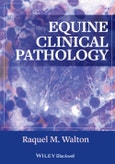Equine Clinical Pathology is the first complete resource for hematology and clinical chemistry in horses. Encompassing the basic principles and advanced interpretation, the book’s single-species approach to pathology allows for focused coverage of the unique disease characteristics of equids. Equine Clinical Pathology is equally useful for anyone using clinical pathology as a diagnostic tool, from beginning student to experienced specialist.
The heart of the book is organized by body system, making it easy to find and apply information. Chapters cover general laboratory medicine, including instruments and techniques, hematology, and proteins as well as specific organs, such as the kidney and liver. Equine Clinical Pathology is a useful bench-side reference for anyone involved in laboratory medicine for the horse.
Table of Contents
Contributors xi
Preface xiii
1 General Laboratory Medicine 3
Raquel M. Walton
General laboratory medicine 3
Basic hematologic techniques 4
Point-of-care testing 6
Test validation and reference values 10
References 14
2 Equine Hematology 15
Raquel M. Walton
Complete blood count interpretation 15
Erythrocyte indices 15
Leukogram 20
Platelets 22
Blood film evaluation 23
Erythrocytes and platelets 25
Leukocytes 30
References 33
3 Immunohematology and Hemostasis 37
Karen V. Jackson
Immunohematology testing 39
Blood typing 39
Crossmatching 41
Antibody screening and jaundiced foal agglutination test 42
Immune-mediated hemolytic anemia 44
Neonatal isoerythrolysis 46
Infection-associated (Clostridial, EIA, R. equi, S. equi) 48
Drug-associated 50
Neoplasia-associated 50
Coagulation testing 51
Physiology of hemostasis 51
Coagulation testing and disorders causing abnormalities 60
References 66
4 The Liver 71
Dennis J. Meyer and Raquel M. Walton
Liver enzymes 71
Hepatocellular enzymes 73
Hepatobiliary enzymes 74
Liver function tests 76
Excretory function tests 76
Tests dependent on synthetic/metabolic functions 77
Other tests 79
Hepatic diseases 80
Toxins 80
Infections 82
Hepatic lipidosis 83
Serum hepatitis (Theiler’s disease) 83
Hepatocellular neoplasia 84
References 84
5 Laboratory Evaluation of the Equine Renal System 87
Andrea A. Bohn
Laboratory assessment of the kidney 87
Glomerular filtration rate 89
Reabsorption and electrolyte regulation 90
Water conservation and blood volume regulation 91
Other renal functions 92
Urinalysis 92
Gross evaluation 92
Urine-specific gravity 92
Reagent test strips 94
Urine sediment exam 95
Laboratory abnormalities associated with different disease states 98
Acute renal failure 98
Chronic renal failure 98
Urinary tract rupture 99
“Early” renal disease 100
Strenuous exercise 101
References 101
6 Acid-Base and Electrolytes 103
Andrea A. Bohn
Acid-base 103
Steps to evaluating acid-base status 104
Bicarbonate 104
Metabolic acidosis and alkalosis 105
Respiratory acidosis and alkalosis 106
Compensatory mechanisms 106
Base excess 107
Electrolytes 107
Sodium 107
Chloride 109
Potassium 110
Calcium 112
Magnesium 114
Phosphate 115
References 116
7 Proteins 119
Koranda Wallace
Plasma proteins 119
Albumin 119
Globulin 120
Acute phase proteins 120
Protein disorders 124
Hypoalbuminemia with hypoglobulinemia 124
Hypoalbuminemia with normal or increased globulins 125
Hypoglobulinemia with normal to increased albumin 125
Hyperalbuminemia 126
Hyperalbuminemia and hyperglobulinemia 126
Hyperglobulinemia 126
Hyperfibrinogenemia 127
References 127
8 Laboratory Assessment of Lipid and Glucose Metabolism 131
Raquel M. Walton
Lipids 131
Triglyceride metabolism 132
Laboratory characterization of lipid metabolism 133
Equine hyperlipidemias 136
Glucose 138
Glucose metabolism 139
Insulin resistance 140
Laboratory characterization of glucose metabolism 140
Diseases associated with glucose metabolic defects 145
References 149
9 Skeletal Muscle 153
Allison Billings
Laboratory evaluation of equine muscle disorders 153
General causes of increased serum enzymes 153
Serum enzymes detecting muscle injury 154
Additional factors affecting CK and AST enzyme activity 158
Other markers detecting muscle injury 159
Equine muscle diseases 161
Immune-mediated myopathies 161
Infectious myopathies 163
Traumatic myopathies 165
Inherited or congenital myopathies 166
Toxic myopathies 169
Nutritional myopathies 171
Myopathies of unknown cause 171
Other myopathies 173
References 173
10 Endocrine Evaluation 181
Jill Beech
Testing for pituitary pars intermedia dysfunction (PPID) 181
Cortisol concentrations 182
Adrenocorticotropin (ACTH) concentration 184
Alpha-melanocyte-stimulating hormone (α-MSH) concentrations 186
ACTH and α-MSH concentration responses following thyrotropin releasing hormone (TRH) administration 186
Insulin concentrations 187
Testing thyroid function in horses 189
Thyroid dysfunction 189
Thyroid hormones 189
Extrathyroidal effects on thyroid hormones 190
Nonthyroidal illness syndrome 192
Thyroid hormone evaluation 192
Thyroid stimulating hormone (TSH) concentration 193
Thyrotropin releasing hormone (TRH) stimulation 194
TSH stimulation test 194
T3 suppression test 195
References 195
11 Fluid Analysis 203
Raquel M. Walton
Pleural and peritoneal fluid 203
Pathogenetic mechanisms of body cavity effusions 204
Body cavity fluid analysis 208
Biochemical evaluation 210
Cells and cell counts 212
Synovial fluid 218
Fluid analysis 219
Degenerative arthropathies 224
Inflammatory arthropathies 225
Eosinophilic synovitis 227
Hemarthrosis 227
References 229
12 Cytology of the Lower Respiratory Tract 233
Martina Piviani
Indications 233
Collection techniques 234
Bronchoalveolar lavage 234
Tracheal wash 234
Sample processing 235
Normal findings 236
Cellular elements 236
Acellular elements 239
Contaminants 240
Interpretation of cytologic patterns 241
Neutrophilic inflammation 241
Mixed neutrophilic and histiocytic inflammation 245
Eosinophilic and mastocytic inflammation 245
Hemosiderosis 246
Cellular atypia 248
References 249
13 Cerebrospinal Fluid 253
Andrea Siegel
Formation, circulation, absorption, and function 253
Collection 254
Laboratory analysis 254
Gross appearance 255
Protein concentration 256
Antibody titers 258
Cell counts 258
Glucose 260
Enzymes 260
Lactic acid 260
Polymerase chain reaction 261
Phenotyping 261
Cytological examination 261
Normal findings 262
Abnormal findings 263
CSF in specific diseases 264
Viral infections 264
Bacterial infections 265
Fungal infections 265
Parasitic infections 266
Other diseases 266
References 266
Index 271








